| Alamy |

|
|
 |
|
ON OCTOBER 17th 1973, Saudi Arabia and several of its oil-rich neighbours voted to cut off oil supplies to America. Two days later, Libya said it would also cut supplies to America and raise the price of oil to other countries from $4.90 a barrel to $8.25 a barrel. Arab frustration at Israel's military victory that month came to a peak on October 21st when Dubai, Qatar, Bahrain and Kuwait cut off supplies too. The Organisation of Petroleum Exporting Countries (OPEC), founded in Iraq in 1960 to promote the interests of producer nations, had finally found its muscle.
|
|
|
 |
|
The Arab embargo has become a symbol of the political chaos and economic troubles endured by the West during the oil shocks of the 1970s. After decades of gradual decline in real terms, oil prices rocketed upwards (see chart 1). Most mainstream forecasters—including those at America's Department of Energy—predicted that oil would cost over $100 a barrel by 2000.
A casual observer of the energy business today might find little changed from that tumultuous autumn of 30 years ago. Once again there is talk of scarcity and crisis. The Middle East is again on the brink of chaos, not only because of Arab countries' resentment over America's support for Israel, but also because of its military occupation of Iraq. And, after years of weakness in the 1990s, OPEC has sprung back to life. Although oil prices have remained around $30 a barrel for some time, and western economies are anaemic at best, the cartel shocked the market last month by voting to cut its output even further.
Moreover, America's Congress is in the final stages of intense negotiation over a huge energy bill that is based on the administration's notion that there is a serious energy-supply crisis. The bill is expected to be passed by Congress any day now. “It's becoming very clear to the country”, George Bush has said, “that demand is outstripping supply.” The Texas oilman's words echo those of Jimmy Carter in 1977. “The diagnosis of the US energy crisis is quite simple,” he said. “Demand for energy is increasing while supplies of oil and natural gas are diminishing.”
If so many things remain unchanged, is the power of OPEC to bring western economies to their knees one of them? The answer to that is complicated: OPEC's power was enhanced by stupid policies pursued by western governments, then reduced by wiser policies of energy conservation, and now is making an alarming comeback.
First, consider what the Arab embargo actually accomplished. In technical terms it was a complete failure: OPEC oil shipped to Europe was simply resold to America or, in effect, it displaced non-OPEC oil that was redirected from Europe across the Atlantic. Prices did rise, but that affected all oil consumers not just Americans. Oil, it became clear at the time, is a “fungible” global commodity. In 1973, Morris Adelman, a professor at the Massachusetts Institute of Technology (MIT), predicted that “if the Arabs don't sell us oil, somebody else will.” He was right.
The petrol queues and shortages in America that are now linked in the popular imagination with that period had little to do with the Arab embargo. Jerry Taylor of the Cato Institute argues, correctly, that the shortages were due chiefly to the misguided, anti-market energy policies that had been adopted by America in the years before the embargo.
In 1971, for example, the Nixon administration imposed price controls on the energy industry that prevented oil companies from passing on the full cost of imported oil to consumers. That led directly, and predictably, to the companies making decisions to reduce their imports and to stop supplying independent petrol stations that they did not own.
Congress made the situation worse in September 1973 by trying to allocate oil to various sectors of industry and different parts of the country through bureaucratic fiat. It also tried to force different pricing for “old” oil and “new” oil—a meaningless distinction for a fungible commodity. These measures led (again predictably) to the panic and hoarding that were to blame for those petrol queues. Both Arab producers and American politicians failed in the 1970s to understand the market forces that lie behind the oil business—that is, the power of supply and demand. Happily, there are signs that both are now a bit wiser to the ways of the market.
In one sense, the cries of oil scarcity heard three decades ago were certainly wrong: the world is not about to run out of hydrocarbons. Thanks to advances in exploration technology, there are more proven reserves of conventional oil today than there were three decades ago. What is more, even if the stuff starts to grow scarce some decades hence, there are great quantities of unconventional oil (such as Canada's tar sands) still to be extracted.
The astonishing burst of innovation in oil technology was the result of investment by big western oil companies in non-OPEC areas such as Alaska and the North Sea. The development of fields in these regions undoubtedly helped to check the market power of OPEC. Unfortunately for consumers, however, these mature oil sources are about to enter a period of dramatic and irreversible decline. This poses an enormous challenge for the big oil companies, which must somehow replace their lost reserves or see their share prices punished by Wall Street.
In a forthcoming study, the International Energy Agency (IEA), a quasi-governmental group of oil-consuming nations, estimates that the oil industry needs to invest as much as $2.2 trillion over the next 30 years in exploration and production. Much has been made about the soon-to-soar energy needs of fast-developing giants like China and India, but only a quarter of that $2.2 trillion is required to meet growth in oil demand; the rest is needed, the boffins say, merely to replace production that is already in decline or soon to decline. Daniel Yergin of Cambridge Energy Research Associates, an industry consultancy, says: “Every day the head of every major oil company wakes up focusing on how he is going to replace his reserves. The pressure is relentless.” If western oil companies do not manage to find new sources of supply, OPEC's market share can only increase—and with increasing market share comes more power.
Where can the companies hope to find new reserves? A glance at the headlines in recent weeks suggests that Siberia is to be the industry's salvation. After a long history of hostility to foreign involvement in energy, it now appears that Russia is putting out the welcome mat. And big oil firms are racing breathlessly across it, given that Russia has the largest reserves of any country outside the Middle East.
BP, which lost $200m in an ill-fated venture with a local company in 1997, appears to have won the first big prize with its new joint-venture with TNK, a big Russian oil firm. Recent rumours suggest that Exxon Mobil and Chevron Texaco may be about to gobble up minority stakes in local firms too. Such acquisitions could be welcomed by YukosSibneft and Lukoil, two of Russia's biggest oil firms. Their owners might be happy to sell now that foreign companies seem eager to pay high prices for businesses such as theirs.
If Russia's fickle politics continues to allow foreign investors in, then the big oil companies should be able to replenish their reserves. That does not mean, however, that the West has found an OPEC slayer. One problem is that it costs far more to lift oil out of the tundra than it does from the sands of the Middle East; indeed, it costs barely a dollar a barrel to extract it from the Saudi or Iraqi deserts compared with an average of about $2.5 a barrel in Russia.
Another reason why Russia will not prove the end of OPEC is that it cannot play the role of swing producer. Saudi Arabia maintains a large amount of excess capacity in order to manage prices and cope with disruptions in supply. Because Russia's oil is in private hands, the country will never be able to maintain such a buffer—no company boss could justify such a waste of shareholders' money. Iraq, whose reserves are cheap but not as plentiful as Saudi Arabia's, is unlikely to become a swing producer because its capacity too is limited. Given the dilapidated state of Iraq's infrastructure and the problem of continuing sabotage, few analysts think that its output will rise even to 6m barrels a day (bpd) in less than a decade—let alone to Saudi levels of over 8m bpd.
There is another reason why Russia will never be a proper counterweight to Saudi Arabia. Vahan Zanoyan of PFC Energy, a consultancy, points out that many of the country's ports are frozen for part of the year. Even if the Russians develop idle capacity, it will be of little use if they cannot get the extra output to market quickly. When political turmoil in Nigeria and Venezuela reduced oil exports on the eve of America's invasion of Iraq this year (which in turn led to a halt in Iraq's limited exports) it was the swift release of oil by the Saudis that kept prices from soaring.
Such moves by Saudi Arabia may seem reassuring, but in fact they point to a cause for great concern: the real problem with the supply of oil is its concentration, not its scarcity. Fully 25% of the world's proven reserves of oil sit under the parched deserts of Saudi Arabia. Add in four of the kingdom's neighbours, and the share of the world's oil reserves held by Middle Eastern OPEC countries soars to about two-thirds. It is this immutable fact that gives the cartel, and especially the Saudis, all the aces in the energy game. Russia, by contrast, sits atop barely 5% of the world's reserves. (Iraq controls about 10%.) The Arctic reserves in Alaska, which are at the centre of so much controversy in America, are insignificant in comparison.
What is more, because the Middle Eastern suppliers are restraining their production in order to prop up prices, they are sure to have plenty of oil left when the non-OPEC countries start to run out of it. That is why official forecasts, such as those of the IEA, suggest that the market share held by countries in the Middle East—especially Saudi Arabia—can only increase over the next two decades.
All this shows that an approach that focuses on the supply of oil, such as that taken by President Bush, can do little to free the world economy from OPEC's grip. An approach that focuses on demand, however, might be a different story. Amory Lovins, the head of Rocky Mountain Institute, a natural-resources think-tank, is among those who argue that demand-oriented policies designed to encourage energy efficiency and conservation can help.
|
|
|
 |
|
During the dark days following the Arab embargo, when most oil economists were convinced that energy use and economic growth had to grow in harness, Mr Lovins insisted that demand-side measures could save the day. In a famous article published in Foreign Affairs in 1976, he argued that America could pursue a “soft path” that would remove the link between energy guzzling and GDP growth. He was widely mocked by the energy industry and mainstream economists at the time, but history has shown him to have been right (see chart 2).
Several forces explain the decoupling of energy use and economic output in the rich world. One is the broad transition from manufacturing to service and information industries, which typically require less energy input. Another is the embrace of policies specifically designed to encourage energy efficiency. In Europe and Japan, governments adopted higher energy taxes on the grounds that the environmental and security “externalities” involved in using oil were not reflected in the market price. In America, politicians decided to use regulation rather than price to encourage efficiency.
The most important, and most controversial, of America's demand-side measures is the Corporate Average Fuel Economy (CAFE) law. As a result of this measure, the average fuel efficiency of new American-made cars rose by over two-fifths from 1978 to 1987. From 1977 to 1985, America's GDP rose by 27%, but its oil use dropped 17% by volume. The volume of America's net oil imports fell by nearly 50% during that time. Mr Lovins argues that the dramatic drop in oil intensity of the American economy “broke OPEC's pricing power for a decade”. The cartel fell into disarray in the late 1980s, and the world enjoyed relatively low and stable oil prices for much of the 1990s.
Demand-side measures like CAFE did help check the cartel's power for some time. However, the automobile industry hates the law and for the past few years has managed to thwart efforts by some in Congress to raise the standards and to close a loophole that exempts trucks and sport-utility vehicles (SUVs). As a result, America has started to return to its gas-guzzling ways of the past. The average fuel efficiency of American vehicles has been near a 20-year low for the past two years.
Beyond these measures, what can the West do to reduce the chances of another oil shock? Stock up on oil, for a start. At the time of the Arab embargo there were no meaningful buffer stocks of petroleum. The wealthy members of the OECD have since agreed to maintain at least 90 days' worth of stocks, and they created the IEA specifically to monitor them.
Critics argue that politicians meddle in the management of these stocks too much; some even suggest that the stocks do not do much good at all. But Claude Mandil, the IEA's boss, insists that they play an important role as an “insurance policy”, which gives Saudi Arabia an incentive to play its role as swing producer and to prevent future oil shocks. If the Saudis do not release their oil, Mr Mandil argues, they know that the IEA will release its own.
This delicate game of cat and mouse points to the harsh reality of today's oil market: it is Saudi Arabia's willingness to be the swing producer that now insures the world's economy against oil shocks. As long as there is a stable government in Riyadh, the West can probably be confident that the enlightened self-interest of the Saudis will coincide with the interests of western gas guzzlers.
Alas, the stability of the Saudi regime is far from guaranteed. The pro-American, ruling family is deeply unpopular with fundamentalists in the country, and there is no clear successor to the current de facto ruler, Crown Prince Abdullah. As even the Saudis now grudgingly concede, home-grown terrorists regularly carry out attacks in the country. And if a radical like the Saudi-born Osama bin Laden were ever to topple the royal family, the world could well be hit by another energy shock.
The conventional view has held that economic reason and American military might would quickly put an end to any such trouble. It is true that any rational rebel, however anti-American, would still sell oil to the world market in order to feed his people. A wilfully irrational zealot, however, might very well shut down the Saudi spigots in an effort to hurt the West.
As for the notion that American troops could quickly restore oil exports, the current morass in Iraq suggests otherwise. If zealots ever got hold of nuclear or chemical weapons and turned them on essential bits of Saudi infrastructure, then all of America's might could not prevent a prolonged and extremely painful oil shock. At a recent conference held on Capitol Hill to reflect on the anniversary of the Arab oil embargo, James Woolsey, a former director of America's Central Intelligence Agency, said: “There are malicious, 9/11 equivalents in the energy system because of our risky reliance on the Saudis as swing producers.”
As the centre of gravity of the world's oil production shifts inexorably closer to Riyadh over the next two decades, this risk can only grow. One statistic makes the point particularly well: even assuming that oil-production technology advances by leaps and bounds, and assuming that four-fifths of all upstream investment in oil takes place outside the Middle East, the IEA still predicts that Saudi Arabia and its immediate neighbours will meet nearly two-thirds of the anticipated increase in oil demand in the years to 2030.
If that is accurate, government stocks, while sensible, will never be able to compensate for the loss of Saudi output for more than a few months. Seeking out new sources of non-OPEC oil abroad, and squeezing out more energy efficiency at home, are surely good things to do as well. But in the end neither will make the world much safer from another oil shock.
Only by finding a radical alternative to oil—another way to power the world's cars and buses—will consuming countries be able to escape a dangerous reliance on Saudi Arabia and its neighbours. Hydrogen-powered fuel cells, and other alternatives such as bioethanol, might provide a means of escape in a decade or two, if pursued vigorously enough in the meantime. Until then, however, the world's addiction to oil remains an increasingly risky gamble on Saudi Arabia.
Copyright © The Economist Newspaper Limited 2004. All rights reserved.